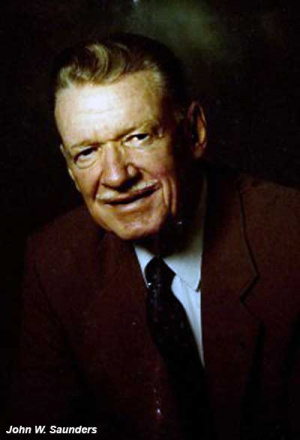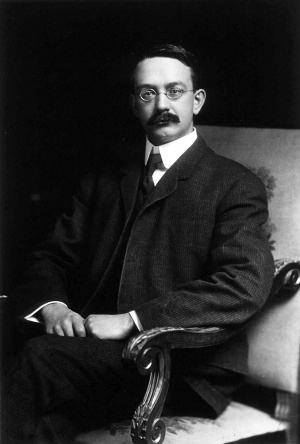Embryology History - John Saunders
| Embryology - 27 Apr 2024 |
|---|
| Google Translate - select your language from the list shown below (this will open a new external page) |
|
العربية | català | 中文 | 中國傳統的 | français | Deutsche | עִברִית | हिंदी | bahasa Indonesia | italiano | 日本語 | 한국어 | မြန်မာ | Pilipino | Polskie | português | ਪੰਜਾਬੀ ਦੇ | Română | русский | Español | Swahili | Svensk | ไทย | Türkçe | اردو | ייִדיש | Tiếng Việt These external translations are automated and may not be accurate. (More? About Translations) |
Introduction
John W. Saunders Jr (1919 ∼ 2015) has had his research reviewed twice in recent years, in 2002[1] and again in 2017.[2]
Dr. Saunders earned his Master’s of science degree in zoology in 1941 from the University of Oklahoma, where he also obtained his undergraduate degree a year earlier. After attending Johns Hopkins University for several years, in 1943 he traveled to the Pacific to serve in the U.S. Navy. Three years later, he returned to Johns Hopkins, where he received a doctorate in 1948.
Following a post-doctoral appointment at the University of Chicago, John taught at Marquette University in Milwaukee, WI, eventually becoming chairman of the department of biology. After a year at the University of Pennsylvania as professor of anatomy, John was appointed leading professor of biological sciences at SUNY New York in 1967 where he remained until 1985 when he was named professor emeritus. Summer research and teaching opportunities brought him first to the Mount Desert Island Biological Laboratory in Salisbury Cove, ME in 1954 and then to the Marine Biological Laboratory in Woods Hole, MA where he was a summer investigator from 1958 to 1972 and again from 1995 to 2003.
John was recognized as an outstanding contributor to the field of developmental biology where his research remains central to understanding of the development of the vertebrate limb. In particular, his studies of a structure known as the apical ectodermal ridge helped identify the role of growth factors in the pattern of the developing limb, and his identification and study of the zone of polarizing activity demonstrated how this area spreads essential information about how surrounding cells are to behave. His early recognition of the role of cell death in development and analyses of feather patterns are also part of his long legacy to scientific understanding. John received many awards during his career, including the Edwin Grant Conklin Medal by the American Society of Developmental Biology in 1996 and the University of Oklahoma College of Arts and Sciences Distinguished Alumni Award in 2007. In 2006, John was elected to the National Academy of Sciences. (text modified from Edwin Grant Conklin Medal SDB announcement)
| Embryologists: William Hunter | Wilhelm Roux | Caspar Wolff | Wilhelm His | Oscar Hertwig | Julius Kollmann | Hans Spemann | Francis Balfour | Charles Minot | Ambrosius Hubrecht | Charles Bardeen | Franz Keibel | Franklin Mall | Florence Sabin | George Streeter | George Corner | James Hill | Jan Florian | Thomas Bryce | Thomas Morgan | Ernest Frazer | Francisco Orts-Llorca | José Doménech Mateu | Frederic Lewis | Arthur Meyer | Robert Meyer | Erich Blechschmidt | Klaus Hinrichsen | Hideo Nishimura | Arthur Hertig | John Rock | Viktor Hamburger | Mary Lyon | Nicole Le Douarin | Robert Winston | Fabiola Müller | Ronan O'Rahilly | Robert Edwards | John Gurdon | Shinya Yamanaka | Embryology History | Category:People | ||
|
1996 Edwin Grant Conklin Medal
Edwin Grant Conklin Medal is presented by the American Society for Developmental Biology.
John W. Saunders, Jr., professor emeritus of biological sciences at the State University of New York at Albany, has spent more than half a century studying the major organizing structure of the vertebrate limb. His studies of this structure -- the apical ectodermal ridge, or AER -- helped to identify the role of secreted growth factors emanating from the AER and how these factors help pattern the developing limb. He and his colleagues were also some of the earliest investigators to look at cell death as a part of normal development. In 1996, Dr. Saunders received the SDB Edwin Grant Conklin Medal for his innovative work in this area. Throughout his career, he has received many other honors, including his election, in 2006, to the National Academy of Sciences, to the American Association for the Advancement of Science, which elected Dr. Saunders a fellow in 1983, and a life member in 1997. “His analyses ... are part of a legacy to developmental biology,” John F. Fallon wrote about Dr. Saunders in a 2002 article in the International Journal of Developmental Biology, adding: “The body of his published work remains central to the understanding of limb development and is a major reason for the premiere place that the developmental biology of limbs holds in our research and teaching today.” Dr. Saunders earned his master’s of science degree in zoology in 1941 from the University of Oklahoma, where he also obtained his undergraduate degree a year earlier. After attending Johns Hopkins University for several years, in 1943 he traveled to the Pacific to serve in the U.S. Navy. Three years later, he returned to Johns Hopkins, where he received a doctorate in 1948. In addition to becoming professor emeritus of biological sciences at the State University of New York (SUNY) at Albany in 1985, Dr. Saunders is a summer embryology staff instructor at the Marine Biological Laboratory (MBL) in Woods Hole, MA, where he has taught since 1995, and where he previously taught from 1958 to 1963.
His prior academic and research appointments include leading professor of biological sciences at SUNY, Albany, from 1967 to 1985; professor of anatomy at the University of Pennsylvania from 1966 to 1967; chairman of the Department of Biology at Marquette University from 1958 to 1965; assistant, associate, and full professor of biology at Marquette University from 1949 to 1965; instructor in zoology at the University of Chicago from 1948 to 1949; graduate assistant in biology at Johns Hopkins University from 1941 to 1948.
Dr. Saunders was a member of corporation of the Mount Desert Island Biological Laboratory in Salisbury Cove, ME, from 1954 to 1983, and, from 1954 to 1958, served as a summer investigator there. In 1959, he became a member of corporation of MBL, where he also served on the board of trustees from 1969 to 1972, and as a summer investigator from 1958 to 1972.
Dr. Saunders has held memberships in a number of prestigious scientific societies, including the American Association for the Advancement of Science, which he joined in 1946. He is an emeritus of the American Association of Anatomists. In 1948, he became a member of the American Society of Zoologists, for which he served as program officer from 1959 to 1962, membership committee chairman from 1959 to 1960, chair of the developmental biology division in 1963, and secretary from 1964 to 1966. He became a member of the International Society of Developmental Biologists in 1957, and the SDB in 1966. From 1967 to 1969, he served on SDB’s executive committee and, in 1968, served as president. Previous memberships also included the Wisconsin Academy of Sciences, Arts and Letters, 1950; American Institute of Biological Sciences, 1957; the New York Academy of Sciences, 1958; Society for Experimental Biology and Medicine, 1964; Association for the Advancement of Aging Research, 1969, and council member from 1969 to 1970; and the Society for Cell Biology, 1960.
Each year since 1995, the SDB has awarded the Edwin Grant Conklin Medal to an eminent scientist with a significant research program in developmental biology and a strong commitment to mentoring young scientists. Edwin Grant Conklin (1863-1952) spent most of his distinguished career in the Department of Biology at Princeton University where, as chair for a quarter of a century, he played a key role in the department’s growth and development.
- Links: SDB Biography
2017 Review
This text abstract from the recent review of John Saunders research.[2]
- "John Saunders was a highly skilled embryologist who pioneered the study of limb development. His studies on chick embryos provided the fundamental framework for understanding how vertebrate limbs develop. This framework inspired generations of scientists and formed the bridge from experimental embryology to molecular mechanisms. Saunders investigated how feathers become organized into tracts in the skin of the chick wing and also identified regions of programmed cell death. He discovered that a region of thickened ectoderm that rims the chick wing bud - the apical ectodermal ridge - is required for outgrowth and the laying down of structures along the proximo-distal axis (long axis) of the wing, identified the zone of polarizing activity (ZPA; polarizing region) that controls development across the anteroposterior axis ("thumb to little finger "axis) and contributed to uncovering the importance of the ectoderm in development of structures along the dorso-ventral axis ( "back of hand to palm" axis). This review looks in depth at some of his original papers and traces how he made the crucial findings about how limbs develop, considering these findings both in the context of contemporary knowledge at the time and also in terms of their immediate impact on the field."
Normal Development of the Wing
These figures are from his 1948 paper on the normal development of the chicken wing.[3]
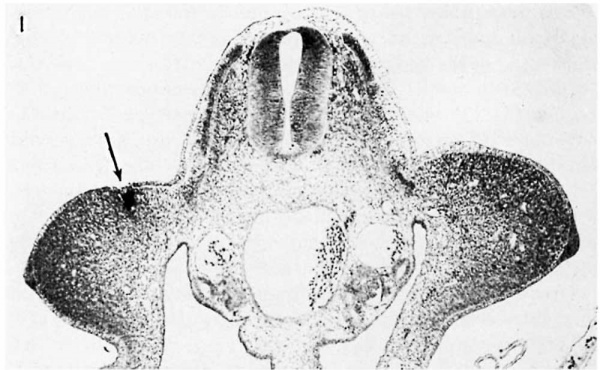
Fig. 1 Cross section through the wing-bud level of a 72-hour embryo (stage 4), showing a small mass of carbon particles (arrow) in the right wing bud. X 75. | |
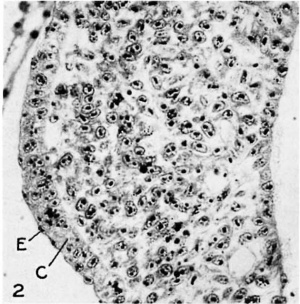
Fig. 2 The mesoblast and covering epithelium of the wing-forming region of a 30 somite embryo, showing epithelial (E) and cuboidal (0) layers of the ectoderm X 450. |
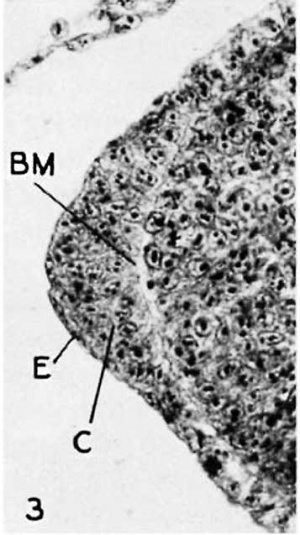
Fig. 3 The apical ectoderm of a wing bud in stage 4. The single-layered epithelium covers the greatly tlniekened euboidal layer. A welI-defined basement membrane (BM) separates the ectodermal cells from the mesoderm. x450 |
References
- ↑ <pubmed>12455620 </pubmed>
- ↑ 2.0 2.1 <pubmed>28625869</pubmed>
- ↑ Saunders JW Jr. The proximo-distal sequence of origin of the parts of the chick wing and the role of the ectoderm. (1948) J Exp Zool. Aug;108(3): 363-403. PMID: 18882505
<pubmed>9846378</pubmed>
<pubmed>14648834</pubmed>
<pubmed>12455620</pubmed>
<pubmed>12230971</pubmed>
<pubmed>9846379</pubmed>
<pubmed>8722474</pubmed>
<pubmed>6193241</pubmed>
<pubmed>7061977</pubmed>
<pubmed>1269832</pubmed>
<pubmed>1269827</pubmed>
<pubmed>4452413</pubmed>
<pubmed>4836526</pubmed>
<pubmed>4826292</pubmed>
<pubmed>4787203</pubmed>
<pubmed>4719010</pubmed>
<pubmed>4561097</pubmed>
<pubmed>4625230</pubmed>
<pubmed>4939251</pubmed>
<pubmed>5459008</pubmed>
20: Fallon JF, Saunders JW Jr. In vitro analysis of the control of cell death in
a zone of prospective necrosis from the chick wing bud. Dev Biol. 1968
Dec;18(6):553-70. PubMed PMID: 5710080.
21: Saunders JW Jr. Death in embryonic systems. Science. 1966 Nov
4;154(3749):604-12. Review. PubMed PMID: 5332319.
22: McWhinnie DJ, Saunders JW Jr. Developmental patterns and specificities of
alkaline phosphatase in the embryonic chick limb. Dev Biol. 1966
Oct;14(2):169-91. PubMed PMID: 4382022.
23: SAUNDERS JW Jr, GASSELING MT. Trans-filter propagation of apical ectoderm
maintenance factor in the chick embrvo wing bud. Dev Biol. 1963 Mar;6:64-78.
PubMed PMID: 13986823.
24: SAUNDERS JW Jr, GASSELING MT. Cellular death in morphogenesis of the avian
wing. Dev Biol. 1962 Aug;5:147-78. PubMed PMID: 14497532.
25: BELL E, GASSELING MT, SAUNDERS JW Jr, ZWILLING E. On the role of ectoderm in
limb development. Dev Biol. 1962 Feb;4:177-96. PubMed PMID: 13866799.
26: ABRAMOFF P, SAUNDERS JW Jr, GASSELING MT. Cytotoxicity of heterologous immune
chicken serum to normal and neoplastic mouse tissues in culture. J Natl Cancer
Inst. 1961 Mar;26:585-99. PubMed PMID: 13681112.
27: GASSELING MT, SAUNDERS JW Jr. Effects of the apical ectodermal ridge on
growth of the versene-stripped chick limb bud. Dev Biol. 1961 Feb;3:1-25. PubMed
PMID: 13703849.
28: BELL E, SAUNDERS JW Jr, ZWILLING E. Limb development in the absence of
ectodermal ridge. Nature. 1959 Nov 28;184(Suppl 22):1736-7. PubMed PMID:
13798486.
29: SAUNDERS JW Jr, GASSELING MT. Effects of reorienting the wing-bud apex in the
chick embryo. J Exp Zool. 1959 Oct-Dec;142:553-69. PubMed PMID: 13746798.
30: ABRAMOFF P, CHINCHINIAN H, SAUNDERS JW Jr. Detection of antigenically
distinctive components of mouse melanoma S91. J Natl Cancer Inst. 1959
May;22(5):919-25. PubMed PMID: 13655070.
31: SAUNDERS JW Jr, GASSELING MT, GFELLER M. Interactions of ectoderm and
mesoderm in the origin of axial relationships in the wing of the fowl. J Exp
Zool. 1958 Feb;137(1):39-74. PubMed PMID: 13563785.
32: SAUNDERS JW Jr, QUEVEDO WC, PIERRO L, MORBECK FE. The effects of tyrosine and
phenylalanine on the synthesis of pigment in melanocytes of embryonic chick skin
cultured in vitro. J Natl Cancer Inst. 1955 Oct;16(2):475-87. PubMed PMID:
13263916.
33: SAUNDERS JW Jr, GASSELING MT, CAIRNS JM. Effect of implantation site on the
development of an implant in the chick embryo. Nature. 1955 Apr
16;175(4459):673-4. PubMed PMID: 14370190.
34: O'BRIEN JP, BELLI JA, WOOD DE, SAUNDERS JW Jr. A new technique for the study
of the effects of x-radiation on mammalian skin maintained at different
temperatures during exposure. Science. 1953 Jul 31;118(3057):135-6. PubMed PMID:
13076213.
35: SAUNDERS JW Jr. The proximo-distal sequence of origin of the parts of the
chick wing and the role of the ectoderm. J Exp Zool. 1948 Aug;108(3):363-403.
PubMed PMID: 18882505.
Saunders JW Jr. An experimental study of the distribution, orientation, and tract specificity of feather germs in the wing of the chick embryo. Anat Rec. 1947 Dec;99(4):647. PMID: 18935452
36: SAUNDERS JW Jr. An experimental study of the distribution, orientation, and tract specificity of feather germs in the wing of the chick embryo. Anat Rec. 1947 Dec;99(4):647. PubMed PMID: 18935452.
Saunders JW Jr. The proximo-distal sequence of origin of wing parts and the role of the ectoderm. (1948) Anat Rec. 1947 Dec;99(4):567. PMID: 18895365
Search PubMed
External Links
External Links Notice - The dynamic nature of the internet may mean that some of these listed links may no longer function. If the link no longer works search the web with the link text or name. Links to any external commercial sites are provided for information purposes only and should never be considered an endorsement. UNSW Embryology is provided as an educational resource with no clinical information or commercial affiliation.
- SDB Biography
- Dev Biol. 2017 In Memory of Dr. John Saunders
- funeral notice
Cite this page: Hill, M.A. (2024, April 27) Embryology Embryology History - John Saunders. Retrieved from https://embryology.med.unsw.edu.au/embryology/index.php/Embryology_History_-_John_Saunders
- © Dr Mark Hill 2024, UNSW Embryology ISBN: 978 0 7334 2609 4 - UNSW CRICOS Provider Code No. 00098G
